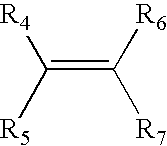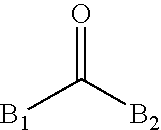Method of directing grafting by controlling the location of high vinyl segments in a polymer
a polymer and high vinyl technology, applied in the direction of film/foil adhesives, special tyres, transportation and packaging, etc., can solve the problems of poor impact strength of brittle resin, difficult to handle the finished polymer in a production environment involving workup and storag
- Summary
- Abstract
- Description
- Claims
- Application Information
AI Technical Summary
Benefits of technology
Problems solved by technology
Method used
Image
Examples
example 1
[0068]A 10-oz. crown-capped N2 purged bottle was charged with 70 grams of a 1,3-butadiene (1,3-Bd) / hexane blend (21.7% 1,3-Bd)), 4.3 mmol of n-butyl lithium (nBuLi), and 2.7 mmol of vinyl modifier bis(2-oxolanyl) (OOPS) at 0° C. (ice-water bath). The bottle was allowed to warm up to 25° C. and left for 18 hours and then 2.7 mmol of triethylaluminum (Et3Al) was added. The resulting high-vinyl polybutadienyl-lithium (60-90% vinyl) (hVBR—Li) was used as the initiator for a polymerization in a 1 gallon stainless steel reactor.
[0069]The reactor was charged with 4.0 lb. of 21.7% 1,3-Bd in hexane blend, 2.0 lb. hexane and the hVBR—Li under N2 pressure. After polymerization for 3 hours at 145-153° F., 210 g of 33% styrene / hexane blend was charged and polymerization proceeded for another 1 hour and 45 minutes. 4.5 mmol OOPS, 4.5 mmol 1,1-DPE (diphenylethylene) were added followed 90 minutes later by 8.6 mmol of benzophenone as the terminator. The resulting polymer had a number average molecu...
example 2
[0071]In a 10-oz. crown-capped N2-purged bottle was charged 72 grams of a 1,3-Bd / hexane blend (21.7% 1,3-Bd), 6.0 mmol of nBuLi, and 3.0 mmol of the modifier OOPS at 0° C. (ice-water bath). The bottle was allowed to warm up slowly to 25° C. and left for 18 hours. Then 3.0 mmol of Et3Al was added. The resulting high-vinylpolybutadienyl-lithium (60-90% vinyl) (hVBR—Li) was used as the initiator for a polymerization in a 1 gallon stainless steel reactor.
[0072]The reactor was charged with 2.5 lb. of 21.7% 1,3-Bd in hexane blend, 2.0 lbs. of hexane, 1.6 lbs. of 33% styrene / hexane, and the hVBR—Li under N2 pressure. After polymerization for 2 hours and 15 minutes at 145-155° F., 6.4 mmol OOPS and 12.0 mmol 1,1-DPE (diphenylethylene) were added followed 180 minutes later by 8.6 mmol of benzophenone as the terminator. The resulting polymer had a Mn 81,700 and Mw / Mn=1.253 with 58.1% styrene (36% block styrene) and 39.1% vinyl content (Bd=100), and was a 5 / 37 / 58 (hvPBd-b-lvPBd-t-PS) ABCF bloc...
example 3
[0073]HIPS was made by dissolving Example 2 block copolymer in styrene—at three different levels—and polymerizing 5 hours at 135° C. The results are shown in Table 1. A high degree of grafting of the ABCF block copolymer rubber with polystyrene was found. Thin 1-2 mm sheets molded at 165° C. from these resins were clear and very flexible.
[0074]
TABLE 1Sample No.123hvPBd-b-lvPBd-t-PS (g)2.02.53.0Styrene (g)8.277.626.95% Conversion Styrene83.9%83.7%77.3%% ABC in HIPS22.4%28.2%35.8%% Elastomer in HIPS15.7%19.7%25.1%Mn of HIPS166,200164,200140,600Mw / Mn225,300214,800194,700% Grafting (Peakfit)80.3%76.4%70.3%
PUM
| Property | Measurement | Unit |
|---|---|---|
| temperature | aaaaa | aaaaa |
| temperature | aaaaa | aaaaa |
| temperature | aaaaa | aaaaa |
Abstract
Description
Claims
Application Information
 Login to View More
Login to View More - R&D
- Intellectual Property
- Life Sciences
- Materials
- Tech Scout
- Unparalleled Data Quality
- Higher Quality Content
- 60% Fewer Hallucinations
Browse by: Latest US Patents, China's latest patents, Technical Efficacy Thesaurus, Application Domain, Technology Topic, Popular Technical Reports.
© 2025 PatSnap. All rights reserved.Legal|Privacy policy|Modern Slavery Act Transparency Statement|Sitemap|About US| Contact US: help@patsnap.com



